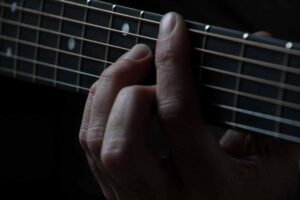How To Sweep Pick
One of the most common requests of guitarists is to learn how to sweep pick. Sweep picking is a variety of methods that allow fluid and expressive motions across the guitar fretboard without picking each string individually. The pick only touches a string one time in the way ‘down’ and one time on the way ‘up.’ But, the devil is in the details.
We’ve had students who’ve been trying to master the technique for years by watching YouTube but still not being able to master the basics. The keys to sweep picking are timing, integration, and biomechanics. You can watch all the videos in the world and still fail after years if you don’t have the right posture and position. Unfortunately, most individuals can’t describe, let alone monitor and correct their guitar posture. Therefore, it’s vital to have a few sessions with a highly skilled teacher if you are having problems sweep picking.
Read the details below for more info and contact us if you want to supercharge your learning. Basic sweep picking mechanics can be learned in just a few short sessions if you have the right instructor. Here’s a step-by-step guide to start learning sweep picking:
- Understand the Technique: Sweep picking involves playing single notes on consecutive strings with a ‘sweeping’ motion, while synchronizing the fretting hand to sound one note at a time. This gives the impression of a rapid, seamless line of notes. Unlike strumming, where several notes on different strings are played seemingly simultaneously to create a chord, in sweep picking you should hear one note at a time in a fluid, time-sensitive fashion regardless of how fast you are sweeping. There should be no muted notes and we can’t overemphasize that timing is critical. If you can’t integrate your right and left hand, or if you are pulsing (going slow and fast, or hesitating) you can’t become a competent sweep picking guitarist.
- Start Slow: As with any complex guitar technique, you should start slow. Use a metronome and start at a very comfortable pace where you can cleanly articulate each note. Over time, gradually increase the speed. A good speed to start is 8th or 16th notes with a metronome set at 25 or 30bpm. Increase the speed by about 5 percent each month depending on how you are practicing. Some individuals can increase faster, others slower, but your top well-articulated speed isn’t dictated by how fast you learn, it’s based on good biomechanics. Do not try and rush with sloppy technique. If your technique is sloppy technique, you’ll top out at a slow speed and it won’t sound right.
- Choose a Simple Arpeggio: Start with a simple shape, like a minor or major triad arpeggio, across 2 to 3 strings. An arpeggio is a type of broken chord where the notes are played in sequence rather than all at once. The basic chord shapes will help you to get used to the movement and build your muscle memory while integrating good biomechanics.
- Right Hand Technique: Start with a downstroke on the lowest string of the arpeggio, then continue the downstroke motion through the next strings, one note per string. When you reach the highest string of the arpeggio, switch to an upstroke and continue the upstroke through each string. The goal is to have your pick moving in one continuous motion, rather than individually picking each string. Try this by muting the strings with your left hand and sweeping with your right hand. Your whole hand should move. If you are just moving your wrist or fingers, you’re are NOT sweep picking.
- Left Hand Technique: The left hand (or fretting hand) should only press down one note at a time, releasing each note before moving on to the next, pay particular attention to how you release. To get speed you need to sweep lightly. To get this to sound good you need to turn up the gain on your guitar—always practice sweep picking amplified on an electric guitar. The faster you go, the higher the gain, the lighter you touch, the more important string muting is. You should hear one note at a time no matter how fast you are going.
- Synchronize Your Hands: It’s crucial that both your hands are in sync. Each time your pick hits a string, your fretting hand should be hitting a note. This will ensure that your sweep picking sounds clean and precise. Also, your right hand should be thumb muting the strings to add more control to your sound. If you do this, you’ll increase your speed steadily until you are blazing fast. One thousand notes per minute is not an unrealistic goal for most guitarists – here’s the kicker – if they use proper biomechanics.
- Use a Metronome: To help with timing and speed, use a metronome while practicing. This can help you to increase your speed gradually and keep time accurately. Start slow and then gradually increase the speed as you become more comfortable. Are you locked into the beat? If you don’t know you’re going too fast. If you can’t hear it, you can’t play it. This means you must exercise your ear so that you can hear individual notes, and this takes time just like integrating your hands.
- Practice Regularly: Like any new skill, practice is key to mastering sweep picking. Try to practice a little bit every day rather than doing long practice sessions sporadically. Five minutes a day will have you increasing speed steadily. Allow yourself time to master this. A five percent speed increase per month with real results is much better than sloppy technique with no increase and you pretending you can sweep pick. Put in your time and always check your technique—if you aren’t increasing there is a problem with your technique.
Be patient with yourself and keep practicing. It’s better to play slowly and accurately than to play quickly and make mistakes. If you make mistakes often enough you burn them in and you are stuck with fast mistakes. Don’t shortchange yourself. Even if you think you can’t do it, you can. Most guitarists spend most of their time surfing YouTube looking for tips on how to play instead of practicing their guitar. If you follow our program, you will see steady increases. We guarantee it!
Our guitar lessons and program help guitarists make the most gains in the shortest among of time. We offer private guitar lessons, small group guitar classes, and short-term specialty classes. We can also assess and correct your biomechanics in one session. Contact us for a phone consultation with our Berklee College of Music Master Certified guitar instructor, Jeff, to see if Peak Music is a good fit for you. Our students come from all over New York’s Capital District including Latham, Albany, Schenectady, Troy, Clifton Park, Cohoes, Watervliet, Niskayuna, and surrounding communities.







